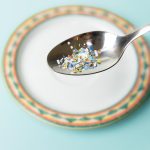Microplastics are destroying your hormones, researchers sound the alarm
 (NaturalHealth365) You’re eating over 50,000 pieces of plastic every year. That’s not a typo. Tiny plastic particles are literally inside your body right now, building up in your organs and disrupting your hormonal system in ways that could change your life forever.
(NaturalHealth365) You’re eating over 50,000 pieces of plastic every year. That’s not a typo. Tiny plastic particles are literally inside your body right now, building up in your organs and disrupting your hormonal system in ways that could change your life forever.
A new study in the International Journal of Molecular Sciences just laid out exactly how bad this problem has gotten. These micro- and nanoplastics are throwing your entire hormonal system into chaos. We’re talking infertility, metabolic dysfunction, and brain damage happening on a massive scale.
Your body is already contaminated
Microplastics are everywhere. Your morning coffee, the water you drink, the air you breathe – it’s all loaded with plastic particles smaller than 5 millimeters. These aren’t harmless bits of debris. They’re packed with hormone-disrupting chemicals that latch onto your hormone receptors and completely hijack how your body works.
Scientists have found these particles in people’s blood, breast milk, saliva, and urine. They’ve even turned up in Arctic ice and on remote mountaintops. If plastic pollution can reach the most isolated places on Earth, what do you think it’s doing to your dinner plate?
The most concerning part is that these particles are like tiny chemical bombs. They’re loaded with substances like phthalates, BPA, and flame retardants that seep directly into your tissues once they’re inside you.
What plastic is doing to your brain
Your hypothalamus controls essential functions, including sleep cycles, appetite, body temperature, and hormone production throughout your body. Plastic particles accumulate in this critical brain region, causing severe damage to its structure and function.
The research shows plastic exposure reduces hypothalamic tissue, triggers widespread inflammation, and creates overwhelming oxidative stress. The chemicals disrupt crucial hormones like vasopressin and oxytocin, leading to significant behavioral and cognitive changes.
When your hypothalamus becomes compromised, it creates a cascade of dysfunction throughout your entire endocrine system. Your reproductive function, metabolism, and stress response all become severely impaired.
Your fertility is under attack
The reproductive system shows some of the most severe impacts from microplastic contamination. Both male and female fertility are experiencing significant damage from these toxic exposures.
In women, plastic particles accumulate directly in ovarian tissue, causing reduced ovarian weight, widespread cell death, and severe oxidative stress. Mouse studies demonstrate decreased egg quality, disrupted menstrual cycles, and increased pregnancy complications.
Male reproductive health shows equally devastating effects. Microplastics accumulate in testicular tissue, reducing sperm count and quality while decreasing testosterone production. Research reveals severe sperm abnormalities, including acephalic (headless) and tailless sperm formations. The extent of reproductive damage is both significant and concerning.
Scientists now suspect that microplastic exposure may be contributing to the documented 80-year decline in male fertility rates observed globally. The evidence suggests we are experiencing widespread reproductive toxicity from plastic contamination.
Your metabolism is getting hijacked
Your thyroid gland controls metabolism and energy production throughout your body, and plastic exposure severely compromises its function. These chemicals interfere with thyroid hormone synthesis, specifically reducing production of critical hormones T3 and T4.
Plastic chemicals block essential iodine uptake required for thyroid function while disrupting gene expression within thyroid cells. The consequences include significantly slowed metabolism, reduced energy levels, and impaired weight regulation.
This thyroid dysfunction poses particular risks for pregnant women and children, whose developing endocrine systems are especially vulnerable to hormonal disruption.
Kids are getting hit the hardest
Children are consuming almost twice as much plastic as adults. Tests on infant stool show way higher concentrations of plastic particles than what’s found in adults.
Kids’ hormone and immune systems are still developing, which makes them highly vulnerable to this kind of chemical assault. Early exposure rewrites their developmental programming, setting them up for reproductive problems, metabolic disorders, and brain damage that could last their entire lives.
Baby bottles are a huge problem. Those silicone nipples release plastic particles every time you sterilize them. Researchers calculated that bottle-fed babies consume about 660,000 plastic particles in their first year alone. The numbers are staggering.
What you can do starting today
The plastic crisis isn’t going away anytime soon, but that doesn’t mean you’re powerless. There are practical steps that can dramatically reduce your exposure starting right now.
Get plastic out of your kitchen. Those plastic containers leaching chemicals into your food? Toss them. Glass and stainless steel won’t poison your leftovers. And never, ever heat anything in plastic – that’s when chemical leaching goes into overdrive.
Your water needs protection. Basic Brita filters won’t cut it for microplastics. You need filtration systems explicitly designed to catch these particles. Consider it an investment in not drinking plastic soup every day.
Synthetic clothing is a problem. Every wash cycle sends thousands of plastic fibers down the drain. They end up in the water supply and back on your dinner plate. Cotton, wool, and linen don’t shed plastic.
Help your body fight back. Your liver works overtime trying to process this plastic chemical cocktail. Support it with plenty of water, antioxidant-rich vegetables, and quality supplements that boost detoxification pathways.
Reconsider that takeout addiction. Those plastic containers aren’t just convenient – they’re loaded with microplastics. Research shows heavy takeout users consume hundreds more particles weekly. Home cooking isn’t just cheaper; it’s cleaner.
These aren’t feel-good suggestions. They’re based on how microplastics enter your system. Cut the sources, support your body’s natural cleanup systems, and you measurably reduce your toxic load. The particles accumulate over the years, so every change counts.
The global crisis requires urgent action
The research makes clear that this isn’t just an environmental issue – it’s a public health emergency affecting the most fundamental aspects of human biology. Every day of delay means more plastic accumulation in your body and more disruption to your hormonal health.
The choice is stark: continue accepting this toxic burden or demand immediate action to protect your health and your children’s future.
Want to discover comprehensive strategies for protecting your body from environmental toxins and supporting your natural detoxification systems? Get lifetime access to the Whole Body Detox Summit, featuring 27 scientists, doctors, and nutritionists sharing powerful insights on detoxification, eliminating toxins, and natural healing protocols. Plus, get up to $1,649 in bonuses, including detox guides and healing strategies. Own the complete summit now and take control of your health destiny.
Sources for this article include:



